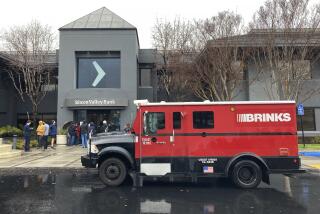Columbia S&L; Loses Almost 10% of Deposits in First Quarter : Thrifts: The company posted a $293-million loss for the period. And liabilities swamped assets by $216 million.
- Share via
Columbia Savings & Loan said Friday that withdrawals exceeded deposits by $741 million in the first three months of 1990, a decline of nearly 10%.
The Beverly Hills-based thrift also announced a $293-million loss in the period.
That contrasts with earnings of $7.9 million in the first quarter of 1989.
That means that Columbia, rendered insolvent last month by heavy losses on its junk bond investments, lost $95 million in March, after previously announced losses of $198 million in January and February. As of March 31, the once-healthy thrift had liabilities that exceeded assets by $216 million. The brightest spot was Columbia’s statement that it has made progress in finding a buyer for its heavy portfolio of junk bonds.
Columbia revealed that its deposit outflow during the first quarter shrunk its base of customer savings to $7.03 billion. Its deposits are insured up to $100,000 by the federal government. Columbia has 29 offices throughout Southern California.
The deposit outflows through March were expected. Most resulted when brokered deposits matured and were not renewed because of customer concern about Columbia’s financial condition. Brokered deposits are funds raised through a middleman, such as an investment banking firm, for a fee.
The question is, to what extent did deposits erode further in April, after Columbia announced devastating losses for 1989 and the first two months of 1990? Columbia’s associate counsel, Charles A. Yamarone, wouldn’t comment. He insisted, however, that Columbia has “sufficient funds available to meet all expected deposit outflows.”
Columbia’s insolvency has made it a likely candidate for a government takeover, but regulators have kept hands off so far. Columbia says it needs more than $338 million to meet the minimum federal requirements for tangible capital, a measure of a thrift’s financial reserve to protect against losses.
Regulators declined comment on Columbia’s latest losses.
Columbia also said it has several potential buyers for its junk bond portfolio. According to a statement, the firm has “obtained several qualifying bids to purchase substantially all of the high-yield bond portfolio in a one-time structured financing.” Company officials declined to elaborate.
Once among the nation’s strongest and most profitable thrifts, Columbia was rendered insolvent by heavy losses in the recent collapse of the junk bond market. Junk bonds are risky, high-yielding corporate debt securities.
Columbia has assets of $8.18 billion, with about a third of it in junk bonds. Thomas Spiegel, Columbia’s former chief executive, is heading the effort to find a single buyer for the bonds. Spiegel could not be reached for comment.
Junk bond industry sources believe that the most likely buyers of Columbia’s portfolio are wealthy private investors who think that the securities will rebound sharply in value and who--unlike banks or insurance companies--do not operate under the scrutiny of government regulators.
The value of Columbia’s junk bonds has been slashed by credit problems as well as writeoffs mandated as part of congressional legislation last year to bail out the savings and loan industry. The law requires savings and loans to sell their junk bonds within five years.
Although Columbia appears hopelessly insolvent, company officials continue to maintain an optimistic public posture about its eventual return to financial health.
In a statement, Columbia Chief Executive Edward G. Harshfield said: “We still feel that Columbia has the ability to achieve timely, full compliance with the capital standards, and we will continue to work toward meeting the challenges imposed on us.” Harshfield was not available for further comment.
More to Read
Inside the business of entertainment
The Wide Shot brings you news, analysis and insights on everything from streaming wars to production — and what it all means for the future.
You may occasionally receive promotional content from the Los Angeles Times.










